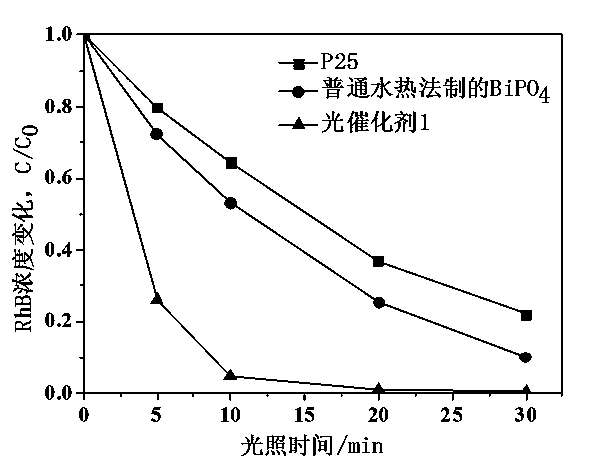Biomimetic synthesis method of high-activity nanometer bismuth phosphate photocatalyst
A photocatalyst and biomimetic synthesis technology, applied in the field of photocatalysis, can solve the problems of difficult preparation of nanoparticles and achieve high photocatalytic activity
- Summary
- Abstract
- Description
- Claims
- Application Information
AI Technical Summary
Problems solved by technology
Method used
Image
Examples
Embodiment 1
[0010] Dissolve 0.685g of soluble starch in 1mol / L nitric acid solution, stir well, add 1mmol of bismuth nitrate, and continue stirring for 2h to obtain a mixed solution; add 1mmol of sodium dihydrogen phosphate to the mixed solution, stir for 0.5h, add Adjust pH=1, continue to stir for 0.5h, transfer to hydrothermal reaction kettle for 24h at 180°C, centrifuge, wash, vacuum dry at 60°C for 4h, and then calcinate at 450°C for 2h to obtain highly active nano phosphoric acid Bismuth photocatalyst 1, figure 1 It is the scanning electron micrograph of the highly active nano bismuth phosphate photocatalyst that the present embodiment makes, figure 2 It is a transmission electron microscope image of the highly active nanometer bismuth phosphate photocatalyst prepared in the present embodiment, and the particle diameter of the bismuth phosphate photocatalyst 1 obtained can be seen from the figure to be 10-50nm.
Embodiment 2
[0012] Dissolve 0.343g of soluble starch in 1mol / L nitric acid solution, stir evenly, add 1mmol of bismuth nitrate, and continue stirring for 2h to obtain a mixed solution; add 1mmol of ammonium dihydrogen phosphate to the mixed solution, stir for 0.5h, add Adjust pH=4, continue to stir for 0.5h, transfer to hydrothermal reaction kettle at 180°C for 24h, centrifuge, wash, vacuum dry at 60°C for 4h, and then calcinate at 400°C for 2h to obtain highly active nano phosphoric acid Bismuth photocatalyst 2.
Embodiment 3
[0014] Dissolve 1.37g of soluble starch in 1mol / L nitric acid solution, stir evenly, add 1mmol of bismuth nitrate, and continue stirring for 2h to obtain a mixed solution; add 1mmol of disodium hydrogen phosphate to the mixed solution, stir for 0.5h, add Adjust pH=7, continue to stir for 0.5h, transfer to hydrothermal reaction kettle for 6h at 210°C, centrifuge, wash, dry in vacuum at 60°C for 4h, and then calcinate at 500°C for 2h to produce highly active nano phosphoric acid Bismuth photocatalyst3.
PUM
 Login to View More
Login to View More Abstract
Description
Claims
Application Information
 Login to View More
Login to View More - R&D
- Intellectual Property
- Life Sciences
- Materials
- Tech Scout
- Unparalleled Data Quality
- Higher Quality Content
- 60% Fewer Hallucinations
Browse by: Latest US Patents, China's latest patents, Technical Efficacy Thesaurus, Application Domain, Technology Topic, Popular Technical Reports.
© 2025 PatSnap. All rights reserved.Legal|Privacy policy|Modern Slavery Act Transparency Statement|Sitemap|About US| Contact US: help@patsnap.com



